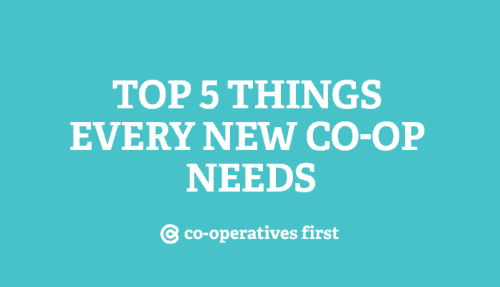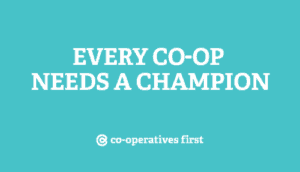
Co-operatives First’s Aasa Marshall with Marty Frost and Shellie Gleave in Fraser Lake, BC.
Marty Frost is an icon in the co-op sector. Through decades of business development experience, Frost has helped set up around 300 co-operatives, both in Canada and internationally. His knowledge of the co-operative business model — along with his signature fedora and friendly white beard — is legendary.
We recently had the privilege of working with Frost, and took the opportunity to pick his brain about All Things Co-op.
For groups wanting to make their co-operative venture a success, here’s 5 things Frost says to keep in mind.
Get others involved
Often one person drives the effort to realize a new co-operative venture. But co-ops by definition (and legislation) require other people to form. The first step is to get a group of engaged, interested people involved – especially those people who might be aligned with or have a vested interest in the outcomes of the venture (profits, increased capacity, service or product).
Initially, those spearheading the effort may have a specific vision for the venture, which can make them inflexible to the ideas of others. Allowing others to influence and enrich the vision is important to fleshing out the idea and exploring options.
Take the time to do things right for your new co-op
It’s natural to be excited about starting a new venture — but it’s also important to take things one step at a time.
Frost has seen people invest in equipment or facilities and take on debt before incorporating the co-operative. Frost says for a stronger, more cohesive co-op, make sure to incorporate first.
Incorporation means thinking through the opportunity and governance a bit before launching straight into operations. It also allows the venture to seek out and take on various forms of capital and funding.
Create a formal structure
Co-ops don’t need to have a hierarchical structure, but they do need to be clear about what their structure is. If it isn’t clear who is responsible for what, confusion and chaos will likely ensue. It is important to differentiate between the governance and management structure of a co-op to ensure accountability. But communicating this structure clearly and consistently (and repeatedly) to shareholders is essential.
“People will be very supportive, they’ll remain supportive of the governance structure as long as they know what’s going on. They may object from time to time, but if they have an avenue to do that and they feel like they’re heard, that’s usually enough,” Frost said.
Create a shared vision for the new co-op
Frost says it’s important to make sure all stakeholders understand and share a vision.
To illustrate, he told us a story about working with a group forming an eco-tourism co-operative.
“There were six people around the table and … about five different visions,” he said. The ideas ranged from “snow-mobile tours and running up the river in power boats to an absolute ecological footprint where there’s no motorized transportation involved.”
Thankfully, once the group recognized the misalignment and spent a day talking and working to find a shared vision for the co-operative, they arrived at a structure everyone was happy with. Often this “muddling through” process can result in a well-structured, successful co-op.
Make sure the co-op model is the right choice for the situation
Frost says knowing when the co-op model is a good fit – and when it isn’t – is an important part of the development process.
While the co-operative business model is versatile and offers great benefits, the model isn’t always the best choice. For a venture to succeed, it’s important to ensure the chosen business model aligns with the values and strategic goals of the organization.
Frost suggests getting to the “why” early in the process. Why a co-op? Or why this type of co-op? What’s the end goal – co-op or not? Understanding what the group is trying to achieve will help make the business model decision a bit easier.





